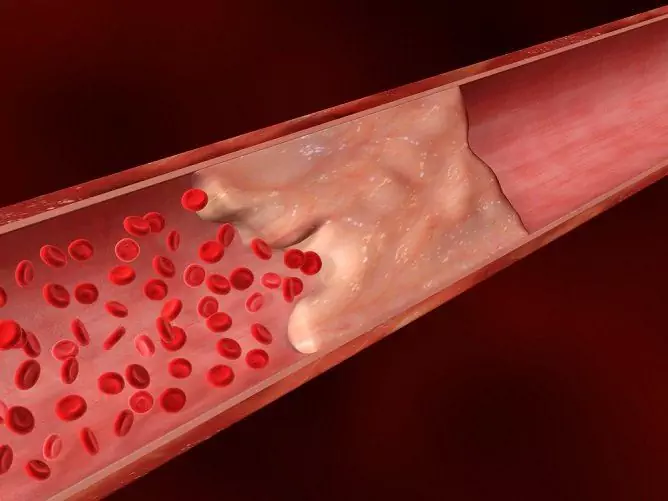- Author Rachel Wainwright [email protected].
- Public 2023-12-15 07:39.
- Last modified 2025-11-02 20:14.
Pneumofibrosis

Pneumofibrosis is the growth of connective tissue in the lungs that occurs under the influence of a dystrophic or inflammatory process. Pneumofibrosis of the lungs leads to a violation of their elasticity and insufficient gas exchange functions of the affected areas.
Types and causes of pulmonary fibrosis
In terms of prevalence, the disease is divided into diffuse pneumofibrosis and local (limited).
Local pulmonary fibrosis is a dense area of lung tissue. At the same time, the volume of the affected lung is reduced. With diffuse pneumofibrosis, the lungs are reduced in volume, dense. The normal structure of the lungs is then lost.
Limited pneumofibrosis does not overly affect the mechanical properties of the lungs and their gas exchange functions. But with diffuse disease, normal ventilation of the lungs is significantly reduced.
As a rule, pulmonary fibrosis is a consequence of various lung diseases, namely:
- chronic obstructive diseases;
- invasive and infectious diseases (pneumonia, including those arising after syphilis, tuberculosis, mycoses, etc.);
- diseases resulting from exposure to the body of gases of industrial origin and corrosive dust, inhalation of various toxic substances;
- hereditary lung diseases.
Often pulmonary fibrosis is a consequence of exposure to toxic drugs or ionizing radiation.
Symptoms of pulmonary fibrosis
Local pneumofibrosis may be asymptomatic.
The main symptom of diffuse pneumofibrosis is shortness of breath, which tends to progress over time. Shortness of breath is often accompanied by a severe dry cough that is aggravated by vigorous breathing. Other symptoms of pulmonary fibrosis include general weakness of the body, aching pain in the sternum, weight loss, and a constant feeling of fatigue. If the patient's basal parts of the lungs are affected, then this leads to the formation of the so-called Hippocratic fingers.
In the later stages of the disease, patients experience a so-called squeak in the lungs, which is similar in sound to the rubbing of a cork. This becomes especially noticeable on inspiration and over the region of the anterior surface of the chest.
Diagnosis of pulmonary fibrosis

The main method for diagnosing this disease is X-ray examination of the lungs. Only this study allows you to get the most objective idea of the changes in lung tissue of a sclerotic nature and differentiate the diagnosis of pulmonary fibrosis from tumor lesions of the lungs.
To determine pneumofibrosis, the patient is prescribed a chest x-ray. Tomography and radiography may be prescribed as concomitant studies. Recently, computed tomography has become of great importance in determining the state of the lung tissue.
Treatment of pulmonary fibrosis
To date, there are no effective methods for treating pulmonary fibrosis. With local pneumofibrosis without symptoms, as a rule, no therapeutic effect is applied at all. If local pneumofibrosis develops as a result of past destructive-inflammatory diseases and proceeds with periodic outbreaks of the infectious process, the patient is prescribed anti-inflammatory and antimicrobial drugs, as well as measures aimed at improving bronchial drainage.
Bronchological examination allows you to determine whether surgical intervention is advisable for the disease.
If the disease is extensive and is due to external factors, then the treatment of pulmonary fibrosis should first of all be aimed at eliminating the causes. Respiratory failure is also treated if necessary.
The prognosis of pulmonary fibrosis depends on various factors, including the complexity of the course of the disease. A decrease in lung size significantly aggravates respiratory failure, in some cases it can cause increased pressure in the pulmonary artery system and the development of cor pulmonale. A lethal outcome is possible if pulmonary fibrosis is complicated by a secondary infection or the development of tuberculosis.
Prevention of pneumofibrosis
The main method of preventing pulmonary fibrosis is the timely detection and adequate treatment of those diseases that contribute to its development. When working with pneumotoxic substances, it is necessary to strictly adhere to safety rules, to carry out regular monitoring aimed at identifying the pneumotoxic effect of various drugs. If any pathological changes are observed in the lungs, it is necessary to urgently take measures aimed at eliminating them.
YouTube video related to the article:
The information is generalized and provided for informational purposes only. At the first sign of illness, see your doctor. Self-medication is hazardous to health!






